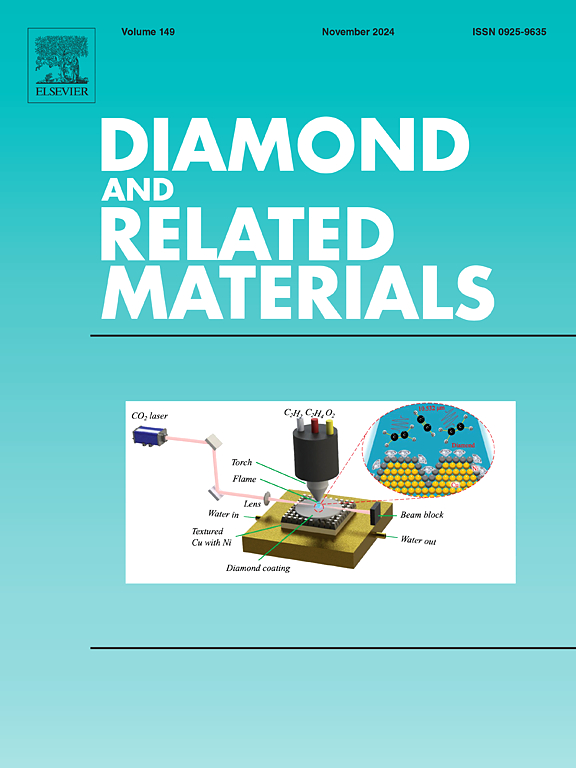基于Ag@AgCl光催化剂的紫外光催化- fenton反应抛光单晶硅工艺参数研究
IF 4.3
3区 材料科学
Q2 MATERIALS SCIENCE, COATINGS & FILMS
引用次数: 0
摘要
针对传统光催化剂tio2光催化活性低、稳定性差、可重复使用性不足等问题,在前期制备了一种新型Ag@AgCl光催化剂。在紫外(UV)照射下,光催化剂利用光生载流子分离和表面等离子体共振效应的特性,高效产生高氧化性羟基自由基,从而显著提高光催化性能,加速单晶硅(SiC)的氧化过程,实现其高效高质量的加工。本研究将这种新型光催化剂应用于单晶SiC的紫外光催化- fenton反应抛光,重点探讨了主要抛光工艺参数对单晶SiC表面质量和材料去除率(MRR)的影响。获得了一套具有较高MRR和表面质量要求的抛光工艺参数。采用单因素实验法研究了磨料类型对单晶SiC表面质量和MRR的影响,并设计了合理的正交优化实验,寻求更好的抛光工艺参数。研究结果表明,在单晶SiC的紫外光催化-芬顿反应抛光工艺中,使用金刚石磨料可以有效地提高抛光效果。在抛光压力为50 kPa,抛光速度为60 rpm,金刚石粒度为200 nm,浓度为2 wt%, h2o2浓度为5 wt%,光催化剂浓度为1.8 wt%的条件下,获得了优异的抛光效果,MRR为1757.6 nm/ H,表面粗糙度Ra为0.45 nm。基于Ag@AgCl光催化剂和优化工艺参数的UV光催化- fenton抛光技术可以在获得高MRR的同时获得高质量的单晶SiC表面。本文章由计算机程序翻译,如有差异,请以英文原文为准。

Study on process parameters of ultraviolet photocatalytic-Fenton reaction polishing of single-crystal silicon carbide based on Ag@AgCl photocatalyst
To address the issues of low photocatalytic activity, poor stability, and insufficient reusability of traditional photocatalyst TiO₂, a novel Ag@AgCl photocatalyst was prepared in the early stage. Under ultraviolet (UV) irradiation, the photocatalyst utilises the characteristics of photogenerated carrier separation and surface plasmon resonance effect to efficiently generate highly oxidative hydroxyl radicals, thereby significantly enhancing the photocatalytic performance, accelerating the oxidation process of single-crystal silicon carbide (SiC), and achieving its high-efficiency and high-quality processing. In this study, this novel photocatalyst was applied to the UV photocatalytic-Fenton reaction polishing of single-crystal SiC, with a focus on exploring the effects of major polishing process parameters on the surface quality and material removal rate (MRR) of single-crystal SiC. A set of polishing process parameters with high MRR and surface quality requirements were obtained. The influence of abrasive types on the surface quality and MRR of single-crystal SiC was studied by single factor experiment method, and a reasonable orthogonal optimization experiment was designed to seek better polishing process parameters. The research results indicate that the use of diamond abrasive can effectively improve the polishing effect in the UV photocatalytic-Fenton reaction polishing process of single-crystal SiC. Under the conditions of polishing pressure of 50 kPa, polishing speed of 60 rpm, diamond particle size of 200 nm, concentration of 2 wt%, H₂O₂ concentration of 5 wt%, and photocatalyst concentration of 1.8 wt%, excellent polishing effect with MRR of 1757.6 nm/h and surface roughness Ra of 0.45 nm was achieved. The UV photocatalytic-Fenton polishing technology, which is based on the Ag@AgCl photocatalyst and optimized process parameters, can achieve a high MRR while also obtaining a high-quality single-crystal SiC surface.
求助全文
通过发布文献求助,成功后即可免费获取论文全文。
去求助
来源期刊

Diamond and Related Materials
工程技术-材料科学:综合
CiteScore
6.00
自引率
14.60%
发文量
702
审稿时长
2.1 months
期刊介绍:
DRM is a leading international journal that publishes new fundamental and applied research on all forms of diamond, the integration of diamond with other advanced materials and development of technologies exploiting diamond. The synthesis, characterization and processing of single crystal diamond, polycrystalline films, nanodiamond powders and heterostructures with other advanced materials are encouraged topics for technical and review articles. In addition to diamond, the journal publishes manuscripts on the synthesis, characterization and application of other related materials including diamond-like carbons, carbon nanotubes, graphene, and boron and carbon nitrides. Articles are sought on the chemical functionalization of diamond and related materials as well as their use in electrochemistry, energy storage and conversion, chemical and biological sensing, imaging, thermal management, photonic and quantum applications, electron emission and electronic devices.
The International Conference on Diamond and Carbon Materials has evolved into the largest and most well attended forum in the field of diamond, providing a forum to showcase the latest results in the science and technology of diamond and other carbon materials such as carbon nanotubes, graphene, and diamond-like carbon. Run annually in association with Diamond and Related Materials the conference provides junior and established researchers the opportunity to exchange the latest results ranging from fundamental physical and chemical concepts to applied research focusing on the next generation carbon-based devices.
 求助内容:
求助内容: 应助结果提醒方式:
应助结果提醒方式:


